The geography of Korea - a peninsula jutting out from the world's largest continent - has contributed greatly to the development of uniquely Korean characteristics. The foundation for the country's culture and arts is the Korean identity: a combination of traits associated with continental and island peoples. Throughout many millennia, Korea has interacted with the predominant continental cultures of Asia despite its peripheral location in the northeast. Remarkably, while accommodating major religions and traditions of other Asian regions, the country has developed a truly distinct culture in many aspects, which some people call the "centrality of the Korean culture."
Under this topographical influence, the Korean people came to develop a peace-loving yet dynamic character that has created a contemplative yet vibrant, optimistic yet sentimental culture.
World Heritage
UNESCO has recognized the unique value and the distinct character of Korean culture by placing a number of Korean treasures on the World Heritage List. In 1995, UNESCO added to its list Bulguksa Temple and Seokguram Grotto, both in Gyeongju, Gyeongsangbuk-do Province; Haeinsa Temple Janggyeongpanjeon, the Depositories for the Tripitaka Koreana Woodblocks in Gyeongsangnam-do Province; and Jongmyo, the Royal Ancestral Shrine in Seoul.
Changdeokgung Palace in Seoul and Hwaseong Fortress in Suwon were entered on the list in 1997. In 2000, two additional Korean treasures were added to the list: the dolmen sites of Gochang, Hwasun and Ganghwa; and the Gyeongju Historic Areas, the capital of the ancient Silla Kingdom (57 B.C.- A.D. 935), where innumerable cultural treasures and historic sites are carefully preserved. In 2007, UNESCO named Korea's volcanic island Jejudo and its lava tubes a natural property of outstanding beauty which bears testimony to the history of our planet. In 2009, 40 royal tombs of the Joseon Dynasty were added to the list. They had been built according to the ancient theory of divination based on topography, known in English by its Chinese name feng shui.
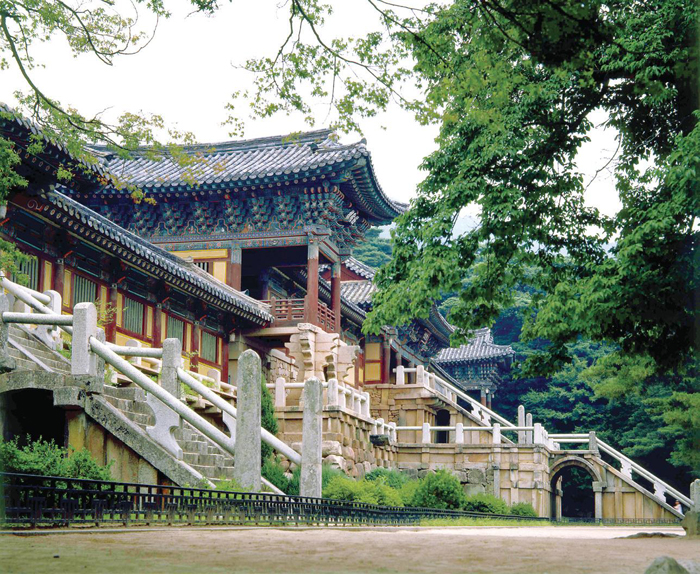
The majestic entrance of Bulguksa Temple in Gyeongju. The temple was inscribed on the UNESCO
Bulguksa Temple and Seokguram Grotto were constructed over a 23-year period beginning in 751 during the Silla Kingdom by Chief Minister Kim Dae-seong (701-774). It is recorded that Kim was reincarnated as the son of a chief minister because he had been the virtuous son of a poor widow in a previous life. He himself became chief minister and resigned in 750 to supervise the construction of Bulguksa to honor the parents of his present life and Seokguram to honor the parents of his previous life. Bulguksa was for public worship and Seokguram for the private worship of the king.
Built on a series of stone terraces, Bulguksa blends into what appears as an organic whole with the rocky terrain of the wooded foothills of Mt.Tohamsan.
The temple houses the Seokgatap (Pagoda of the Historic Buddha) and Dabotap (Pagoda of Many Treasures) as well as Cheongungyo (Blue Cloud Bridge), Baegungyo (White Cloud Bridge) and Chilbogyo (Bridge of Seven Treasures) - the three staircases are called bridges because symbolically they lead from the secular world to the spiritual one of Buddha. There are many other outstanding treasures within and outside the temple grounds, including gilt bronze Buddha statues.
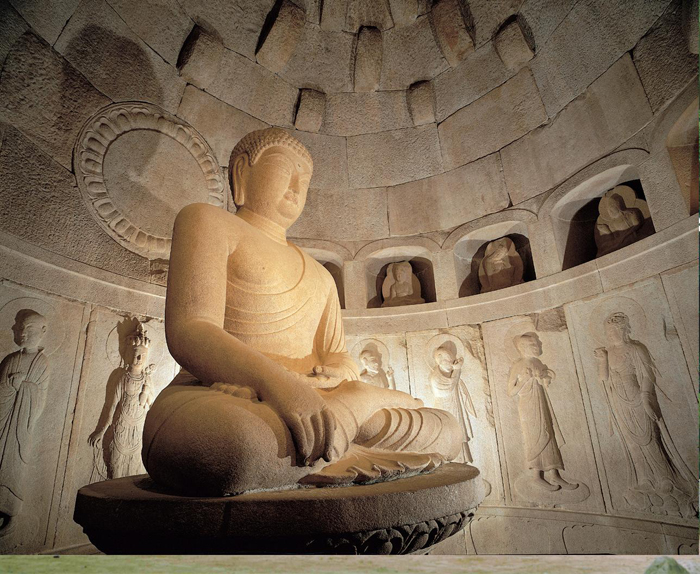
Main Buddha of Seokguram Grotto at the Bulguksa Temple complex
Dominating the courtyard of the Daeungjeon (Main Hall) are two of Korea's most beautiful pagodas. The 8.3-meter-high Seokgatap and the 10.5-meter-high Dabotap were both built around 756. Seokgatap is characterized by masculine simplicity and princely dignity and represents spiritual ascent via the teachings of Sakyamuni whereas the highly decorative Dabotap is more feminine and symbolizes the complexity of the world.
Seokguram Grotto has undergone renovation several times over the years. It is an artificially created stone cavern featuring a large seated Buddha surrounded by 38 Bodhisattvas. The grotto, like the structures in the vicinity of Bulguksa, is made from granite.
Seokguram comprises a rectangular antechamber and a round interior chamber with a domed ceiling connected by a passageway. Chiseled out of a single block of granite, the 3.5-meter-high main Buddha is seated cross-legged on a lotus throne facing the east, with eyes closed in quiet meditation, and a serene, all-knowing expression on its face. Seokguram represents a combination of Silla's knowledge of architecture, math, geometry, physics, religion and art into an organic whole and is one of Korea's greatest Buddhist masterpieces.
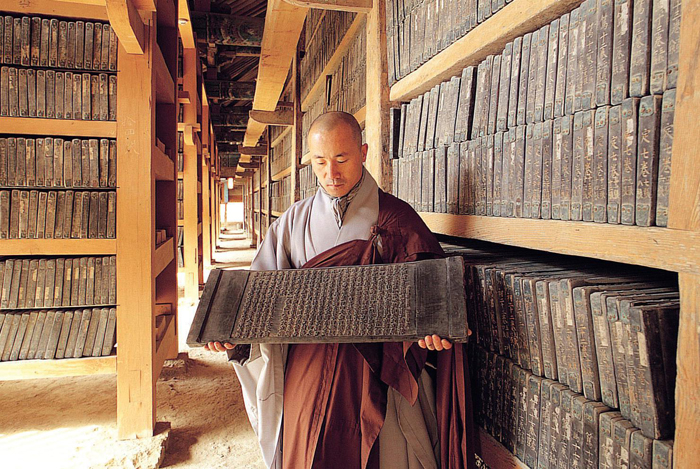
Haeinsa Temple Janggyeong Panjeon, the Depositories for the Tripitaka Koreana Woodblocks
Janggyeong Panjeon, two storage halls at Haeinsa Temple, are the repositories for the Tripitaka Koreana, consisting of some 81,258 wood printing blocks, the Goryeo Dynasty version of the Buddhist canon. With more than 52 million Chinese characters precisely rendered, it is the oldest and most comprehensive Buddhist canon existing in the world today.
Jongmyo, the Royal Ancestral Shrine, was dedicated in 1395, three years after the Joseon Dynasty was established. It enshrines the spirit tablets of its kings and queens. The elaborate memorial rites and the music, which accompanies them called Jongmyojeryeak, were designated as Masterpieces of the Oral and Intangible Heritage of Humanity. Ceremonial reenactments of the Joseon ancestral memorial rites are conducted on the first Sunday of every May at Jongmyo.
Changdeokgung Palace was first built in 1405 and was reconstructed after being burnt down in 1592 during the Japanese invasion. The palace itself is a masterful work but particularly noteworthy is the back garden (Huwon), also called the Secret garden (Biwon), which is widely acclaimed for its beautifully landscaped and creative gardens. The garden comprises almost three-quarters of the 405,636 m
2 palace grounds and is tastefully laid out with all the essential elements of a Korean traditional garden: picturesque pavilions and halls, lotus ponds, uniquely shaped rocks, stone bridges, stairways, water troughs and springs scattered among dense woods.

- 1. Changdeokgung Palace - Located in Jongno-gu, Seoul, the palace was constructed during the Joseon period.
- 2. Dolmen - Representative type of tomb from the Bronze Age in Korea
- 3. Hwaseong Fortress - A unique example incorporating features of modern military architecture from both the East and the West.
- 4. Silla Kingdom tombs in Gyeongju - These are royal tombs from the Silla Kingdom within the Gyeongju Historic Areas.
- 5. Jongmyo Shrine - Confucian royal shrine that houses tablets of deceased kings and queens of Joseon.
Hwaseong Fortress was constructed over 34 months in Suwon, south of Seoul, in 1796. The fortress incorporated the very latest construction technology, theories of military defense and aesthetic principles to create the most advanced military stronghold Korea had ever known. It stretched over undulating terrain around an urban center and included four major and several minor gates, command posts, observation towers, battlements, guard posts and bunkers. Most of the 5,743 meter exterior fortress wall still remains.
The Gyeongju Historic Areas and dolmen sites in the counties of Gochang, Jeollabuk-do; Hwasun, Jeollanam-do; and Ganghwa, Incheon, were also added to the list in 2000. Gyeongju was the capital of the Silla Kingdom for a thousand years and the area is called a "Museum Without Walls" because of the wealth of historical properties there.
Jeju Volcanic Island and Lava Tubes together comprise three sites that make up 18,846 hectares. They are Geomunoreum, regarded as the finest lava tube cave system anywhere, with its multicolored carbonate ceilings and floors and dark-colored lava walls; the dramatic fortress-like Seongsan Ilchulbong crater rising out of the ocean; and Hallasan, South Korea's highest mountain, with its waterfalls, multi-shaped rock formations and small crater lake. These sites of outstanding aesthetic beauty also bear testimony to the history of the planet, its features and the processes which formed our world.

- 1. Hahoe Village - the oldest historic clan village in Korea, was inscribed on the UNESCO World Heritage List in 2010.
- 2-3. Jejudo Island with its many volcanic features has greatly improved understanding of global volcanism and ecosystems. The beautiful scenery of Mt. Hallasan, biodiversity, and geographical features are of outstanding universal value as world natural heritage.
- 4. Joseon Dynasty's Royal Tombs - Gyeongneung (King Heonjong)
The Joseon Dynasty's Royal Tombs were built adhering to the principles of Confucianism, the ruling ideology of the times, and "pungsu," the Korean version of geographic divination known as feng shui in China. They boast a kind of beauty that cannot easily be found in the graves of other countries. The tombs reflect the perspectives on nature and the universe during the Joseon period with their spatial layout, architectural design and usage, and the scale of stone objects. The cultural value of the tombs can further be seen in the maintenance of the tradition of holding ancestral rites throughout the long history of the Joseon Dynasty down to the present.
In July 2010, the World Heritage Commission in its 34th general meeting in Brasilia, Brazil, approved the listing of Hahoe and Yangdong Villages, both located in Gyeongsangbuk-do Province, as World Heritage sites for their unique cultural values. They were recognized for the preservation of the Confucian-oriented, clan-centered Joseon era civilian life.
Memory of the World Register
In 1997, UNESCO initiated a Memory of the World Register for the purpose of preserving and disseminating the documentary heritage of the world that is in danger of being lost forever. Korean additions to this registry include Hunminjeongeum (Proper Phonetics to Instruct the People), Joseonwangjosillok (Annals of the Joseon Dynasty), Buljo Jikjisimcheyojeol (Selected Sermons of Buddhist Sages and Seon Masters), Seungjeongwon Ilgi (Diaries of the Royal Secretariat), the printing woodblocks of the Tripitaka Koreana and miscellaneous Buddhist scriptures, the Uigwe (Royal Protocols of the Joseon Dynasty), and Donguibogam, the Principles and Practice of Eastern Medicine.
Hunminjeongeum was a primer for teaching Hangeul, the Korean alphabet created by the Joseon Dynasty's fourth ruler, King Sejong the Great (r. 1418-1450). The new alphabet was promulgated in 1446.
Joseonwangjosillok resulted from the tradition of preparing a historic record of each reign. It began in 1413 with the Annals of King Taejo, the founder and first king of Joseon, and continued through the end of the dynasty in 1910. The Annals were drafted by historians in the Office for Annals Compilation (Chunchugwan), and to ensure preservation, copies were stored in special repositories situated in different parts of the country.
Buljo Jikjisimcheyojeol, compiled in 1372 by the monk Baegun (1298-1374), contains the essentials of Seon (Zen) Buddhism. The key words of the title, "Jikjisimche" were taken from a famous phrase about attaining enlightenment through the practice of Seon. A colophon on the last page of the book states that it was printed with movable metal type at Heungdeoksa Temple in 1377, about eighty years before the Gutenberg Bible was printed in Germany, making it the world's oldest book printed with movable metal type.
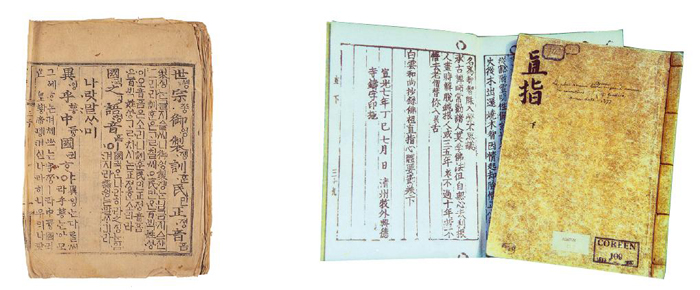
Hunminjeongeum(left): Published in 1446, the 28th year of King, Buljo Jikjisimcheyojeol: Printed in 1377, this is the world’s oldest book
The Seungjeongwon, the Royal Secretariat of the Joseon Dynasty, was responsible for keeping the Seungjeongwon Ilgi, a detailed record of the daily events and official schedule of the court, from Joseon Dynasty's first king, Taejo (r. 1392-1398), to the 27th and last, Sunjong (r. 1907-1910). However, currently only 3,243 volumes exist. Recorded in the Seungjeongwon Ilgi is the largest amount of authentic historic information and state secrets of the Joseon Dynasty. It served as the primary source for the Annals of the Joseon Dynasty, thus its historic value is even greater than the Annals itself.
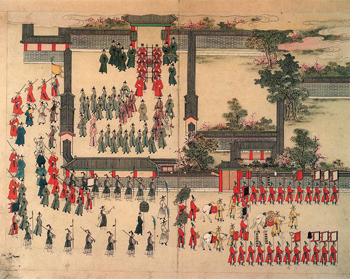
Uigwe - The Royal Protocols of the Joseon Dynasty
The Goryeo Daejanggyeong (Goryeo Dynasty Tripitaka), known as the "Tripitaka Koreana" to modern scholars, is a collection of the Tripitaka (Buddhist scriptures). Carved onto 81,258 wooden printing blocks in the 13th century, under commission by the Goryeo Dynasty (918-1392), it is currently stored at Haeinsa Temple in Gyeongsangnam-do Province.
A unique form of documentary heritage, the Uigwe is a collection of Royal Protocols for the 500-year-long Joseon Dynasty. A comprehensive and systematic collection of writings and paintings, it provides a detailed account of the important ceremonies and rites of the Joseon court. Its particular style of documentary heritage cannot be found anywhere else in the world.
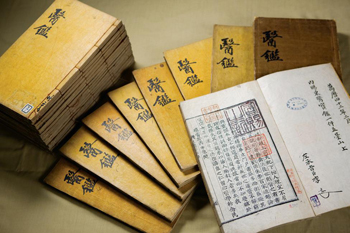
Donguibogam: This is the greatest-ever oriental medical treatise in Korea. Written by Heo Jun (1546?~1615), this landmark medical book was completed in 1610. Inscribed on the UNESCO World Heritage List in July 2009.
Donguibogam (The Principles and Practice of Eastern Medicine) is an encyclopedia of medical knowledge and treatment techniques compiled and edited by Heo Jun (1539-1615) in the early 17th century, with the collective support of medical experts and literati, according to instructions from the royal court. The work shows the evolution of medicine in East Asia and beyond. In terms of health care system, it developed the ideals of preventive medicine and public health care by the state, which were virtually unprecedented ideas.
Ilseongnok is a chronicle of each king’s activities and every aspect of state administration in the late Joseon period. Compiled in the form of a daily journal, it covers all state affairs from 1760 (36th year of the reign of King Yeongjo of Joseon) to 1910 (4th year of the reign of Emperor Sunjong of the Great Han Empire).
The May 18 The Gwangju Democratic Movement’ refers to the struggle for democratization waged by the inhabitants of Gwangju against the military dictatorship between May 18 and May 27, 1980. The movement is said to have had a significant influence on democratization movements in East Asia in the ensuing period. Records concerning the movement, including documents, photos and films, and compensation for the victims, are kept by the May 18 Memorial Foundation, the National Archives of Korea, the ROK Army Headquarters, the National Assembly Library, and the United States government.
Intangible Cultural Heritage of Humanity
In 1998, UNESCO created the Proclamation of Masterpieces of the Oral and Intangible Heritage of Humanity to protect the oral and intangible cultural heritage of the world. Since the first proclamation in 2001, three intangible cultural treasures of Korea have been proclaimed Masterpieces, and these include the Jongmyojerye and Jongmyojeryeak (Royal Ancestral Rite and Ritual Music), pansori (epic songs), and the Gangneung Danoje Festival. In 2010, UNESCO added to its list Gagok, lyric song cycles accompanied by an orchestra; Daemokjang, traditional wooden architecture; and falconry.
As the Convention for the Safeguarding of the Intangible Cultural Heritage of Humanity was adopted in 2003, all the items that had been proclaimed Masterpieces were automatically incorporated in the Representative List of the Intangible Cultural Heritage of Humanity in 2008. In 2009, five items were newly inscribed on the Representative List, and they include Ganggangsullae Circle Dance, Namsadang Vagabond Clowns' Play, the Rites of Vulture Peak, Jeju Rites for the Goddess of the Wind, and the Dance of Cheoyong.
Jongmyojerye is the ancestral memorial rite held for the repose of the spirits of the kings and queens of the Joseon period at Jongmyo (the Royal Ancestral Shrine) where their spirit tablets are enshrined. Jongmyojeryeak is played during the rites. Accompanied by ritual dancing, Botaepyeong (Maintaining the Great Peace) was a suite of 11 pieces praising the civil achievements of the dynastic founders and Jeongdaeeop (Founding a Great Dynasty) was a suite of 15 pieces praising their military accomplishments. These two works were composed in 1447 and revised in 1464 into 11 pieces, respectively. Two additional pieces, known as Jongmyoakjang were composed a few years later.
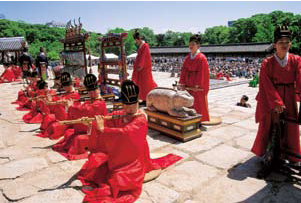
Jongmyojeryeak (Royal ancestral ritual music)
Hundreds of officials, musicians, dancers and attendants take part in the event, which reflects the solemnity and magnificence of Confucian rituals. It is a rare example of an intangible cultural masterpiece that has maintained its original form for 500 years.
Pansori is a genre of musical story-telling, performed by a vocalist with drum accompaniment. These popular solo epic songs, characterized by expressive singing, stylized speech, and mimetic gestures, embrace both aristocratic and folk culture. Pansori is a compound word from "pan" (a public place where people gather) and "sori" (song). Performances can last up to eight hours, where a male or female singer improvises on texts that combine rural Korean dialects with erudite literary expressions. The settings, characters and situations that make up the pansori are rooted in the Joseon period.
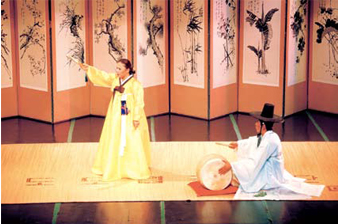
Pansori - A genre of musical story-telling, performed by a vocalist with drum accompaniment.
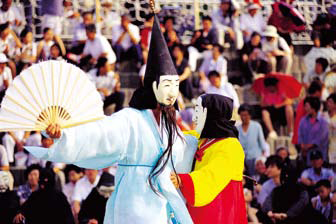
Mask dance from the Gangneung Danoje Festival
Danoje, held to pray for a good harvest, falls on the fifth day of the fifth lunar month and marks the end of the spring barley and rice-planting season. Traditionally it was one of the three most important holidays along with Seollal (Lunar New Year's) and Chuseok (Thanksgiving). Gangneung's Danoje Festival in Gangwon-do Province is the largest traditional festival in Korea and lasts nearly four weeks in the fourth to early fifth month of the lunar calendar. The music, dance, literature, drama and handicrafts associated with the festival are of high artistic value and have extraordinary worth in that the festival has continued for approximately a thousand years and reflects the history and life of commoners. The festival also incorporates Korean religious traditions, including Confucianism, Shamanism, Buddhism and Taoism and offers a diversity of ceremonies and performances.
Traditionally, the Ganggangsullae Circle Dance was performed in Korea at night as part of representative seasonal holidays and festivals such as Seollal, Daeboreum (the first full moon of the new year on the lunar calendar), Danoje, Baekjung (Buddhist ceremony held on July 15th to honor the souls of the dead), Chuseok and Junggu (festival held on September 9th on the lunar calendar). In particular, the largest Ganggangsullae Circle Dance was carried out at night on Chuseok.
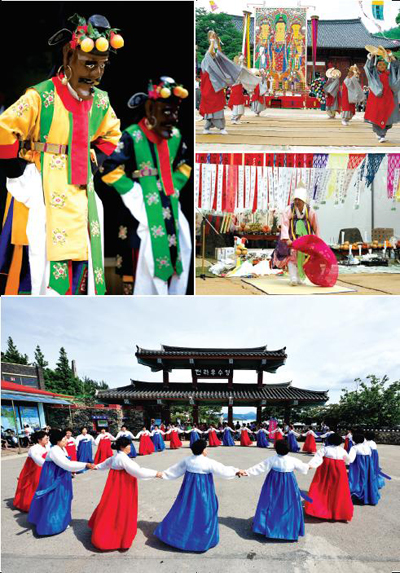
(Clockwise from top left) 1. Cheoyongmu refers to a dance carried out while wearing a mask of Cheoyong. 2. Yeongsanjae refers to a Buddhist ceremony that is generally conducted on the 49th day after a person’s death to help the soul of the deceased find its way into Nirvana. 3. Jeju Chilmeoridang Yeongdeunggut is a shaman ritual (gut) conducted at the Chilmeoridang Shrine located in Geonip-dong, Jeju. 4. The Ganggangsullae Circle Dance is a primitive art form combining song, dance, and music that can be likened to a Korean-style ballad dance.
The Ganggangsullae Circle Dance is a primitive art form combining song, dance, and music that can be likened to a Korean-style ballad dance. The performance of the Ganggangsullae Circle Dance involves a circle of women dancing while holding hands. While one acts as the lead vocal (sori), the rest of the women in the group respond to the lead singer with the next lines of the song. The folklore and folkdance inherent in this art form are accompanied by folk music performed with Korean traditional instruments such as buk (drum) and janggu (hourglass-shaped drum).
Jeju Chilmeoridang Yeongdeunggut (Jeju Rites for the Goddess of the Wind) is a shaman ritual (gut) conducted at the Chilmeoridang Shrine located in Geonip-dong, Jeju. Geonip-dong is a small village on Jejudo Island whose denizens earn a living from fishing, collecting shells, and working as haenyeo (female divers). Traditionally, villagers implemented shaman rituals in which they prayed for peace and a good harvest for the village to the magistrate god and the sea goddess. At a designated time, rites are held throughout Jeju Island to implore the Yeongdeung (goddess of the wind) for calm seas and an abundant catch. In this regard, the rite known as the Jeju Chilmeoridang Yeongdeunggut incorporates both the haenyeo belief and folk beliefs associated with the Yeongdeung. Its uniqueness and academic value lies in the fact that it is the only rite conducted by haenyeo.
Namsadangnori (Namsadang Vagabond Clowns' Play) refers generally to performances staged by the Namsadangpae, a vagabond troupe of 40 or more male performers. Geared towards the common people, the Namsadangnori was performed in rural areas, or on the outskirts of towns.
In other words, not only could the roots of the Namsadangnori be traced back to the commoner class, but such performances were prepared and staged with them in mind.
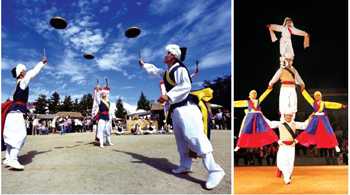
Namsadangnori refers generally to performances staged by the Namsadangpae, a vagabond troupe of 40 or more male performers.
These performances were designed to lighten the mood of the masses suffering under the yoke of oppression, but they also, through their socially-relevant humor, provided a venue for the criticism of the immorality of the yangban (noble class), and served as a catalyst for the development of the consciousness of the minjeong (people).
Yeongsanjae (Rites of Vulture Peak) refers to a Buddhist ceremony that is generally conducted on the 49th day after a person's death to help the soul of the deceased find its way into Nirvana. Having originated from a rite conducted by Sakyamuni at Mt. Gridhrakuta in India as the latter preached the Lotus Sutra, Yeongsanjae has now come to symbolize the reproduction of the Yeongsan Hoesang (Assembly of Sakyamuni Preaching at Vulture Peak). A shining example of Korea's traditional culture, Yeongsanjae is meant to not only help the souls of the deceased, but also those of the living so that the latter can become enlightened to the truth of Buddha, thereby helping them to do away with all their worldly concerns. This event is not so much a performance as it is a majestic Buddhist ceremony that draws in the participation of the people.
Cheoyongmu (Dance of Cheoyong) refers to a dance carried out while wearing a mask of Cheoyong. It is the only court dance performed on the stage while wearing masks with a human-like appearance. This mask dance is based on the legend of Cheoyong associated with the reign of King Heongang (r. 875-886) of Unified Silla. Cheoyong is said to have used singing and dancing to drive away the evil spirit (god of pestilence) that had seduced his wife. The Cheoyong dance also connotes the warding off of evil based on the theories of Yin-Yang and the Five Elements. Featuring vigorous and colorful dance moves, the dance's dynamic movement patterns exude a sense of magnanimity and vivaciousness that unfolds in harmony with the masks.
Gagok (long lyrical song) is a genre of Korean traditional vocal music accompanied by a small ensemble of Korean traditional musical instruments. Distinct from pansori (musical drama), minyo ("folk songs"), and japga ("miscellaneous songs"), gagok is a form of classical music called jeongga, or 'right song.' Gagok flourished during the Joseon period. It uses sijo, Korean traditional poetry, as lyrics, allowing us a glimpse into the spirit of the Koreans long ago and their appreciation of the arts. In modern times, gagok has been developed as song to be enjoyed by both the singer and the audience.
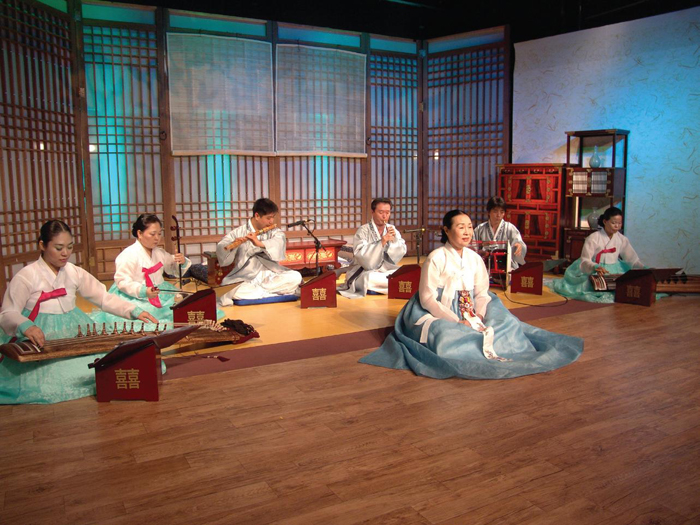
Gagok is a genre of Korean traditional vocal music accompanied by a small ensemble of Korean traditional musical instruments.
Daemokjang refers to a master carpenter or artisan who builds important buildings such as palaces, temples, and houses, or to their craftsmanship. Daemokjang can be seen as a traditional title equivalent to an architect today. The inscription of Daemokjang on the List of Intangible Cultural Heritage of Humanity is meaningful in that it is the first form of Korean craftsmanship to be so inscribed. The restorations of Changdeokgung Palace, a UNESCO World Heritage Site, and more recently, Gwanghwamun Gate and Sungnyemun Gate, were led by Daemokjang.
Falconry, the traditional activity of keeping and training falcons and other raptors to capture wild game or fowl for the hunter, is one of the oldest hunting sports known to man. Inscription of falconry on the UNESCO Intangible Cultural Heritage Lists is meaningful for Korea in that falconry was shared with 10 other countries including the United Arab Emirates, Belgium, France, and Mongolia.
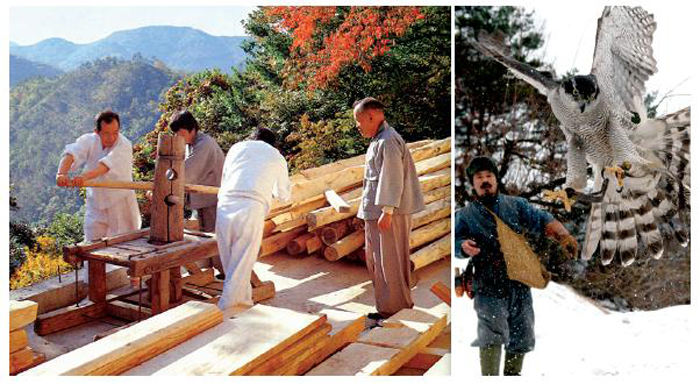
Daemokjang refers to a master carpenter or artisan who builds important buildings such as palaces, temples, and houses, or to their craftsmanship. (left) Falconry, the traditional activity of keeping and training falcons and other raptors to capture wild game or fowl for the hunter, is one of the oldest hunting sports known to man. (right)
Jultagi, Tightrope walking is a widespread form of entertainment that in most countries focuses purely on acrobatic skill. The traditional Korean performing art of Jultagi is distinctive in that it is accompanied by music and witty dialogue between the tightrope walker and an earthbound clown. Jultagi is performed outside. The tightrope walker executes a variety of acrobatic feats on the rope, along with jokes, mimicry, songs and dance, while a clown engages the tightrope walker in joking banter, and a team of musicians plays music to accompany the entertainment. The tightrope walker starts with simpler feats, gradually moving to more difficult acrobatics, displaying some forty different rope techniques in a performance that can last several hours. Today, tightrope walking performers are frequently invited to local festivals that take place throughout the country, particularly in spring and autumn. Currently, transmission of tightrope walking in Korea is centred on the Jultagi Safeguarding Association in Gyeonggi Province.
There are two types of training: apprenticeship education where masters educate practitioners and take on students, and public education which takes various forms such as school training, experience classes and summer camps.
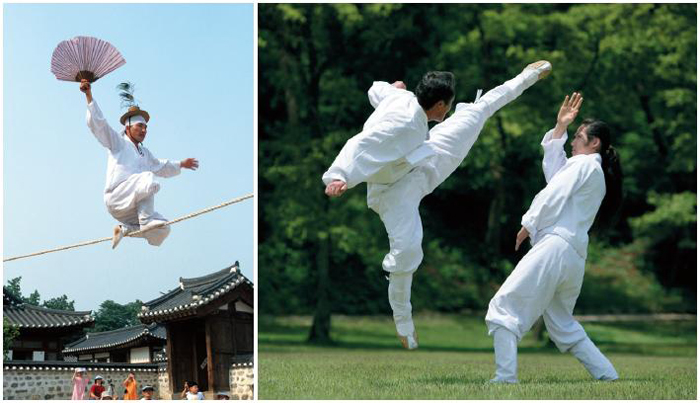
A master of Jultagi tightrope walking uses a fan to adjust his balance. (left) A traditional Korean martial art, Taekkyeon is characterized by fluid yet powerful movements of the hand and feet that allow fighters to subdue their opponents with swift force. (right)
Taekkyeon is a traditional Korean martial art that makes use of fluid, rhythmic dance-like movements to strike or trip up an opponent. The graceful movements of a well-trained Taekkyeon performer are gentle and circular rather than straight and rigid, but can explode with enormous flexibility and strength. The feet play as important a role as the hands. In spite of its gentle impression, Taekkyeon is an effective martial art highlighting a broad variety of offensive and defensive skills employing all available fighting methods. It also teaches consideration: a skilled Taekkyeon practitioner can rapidly dominate an opponent, but a true master knows how to make an opponent withdraw without incurring damage. As a part of seasonal farming-related traditions, Taekkyeon serves to facilitate community integration, and as a sport accessible to all plays a major role in promoting public health. Taekkyeon is also practised by a great number of people as a daily activity. There are approximately fifty recognized practitioners of Taekkyeon at present, and the Korean Taekkyeon Association plays a significant role in the transmission and promotion of this traditional martial art.
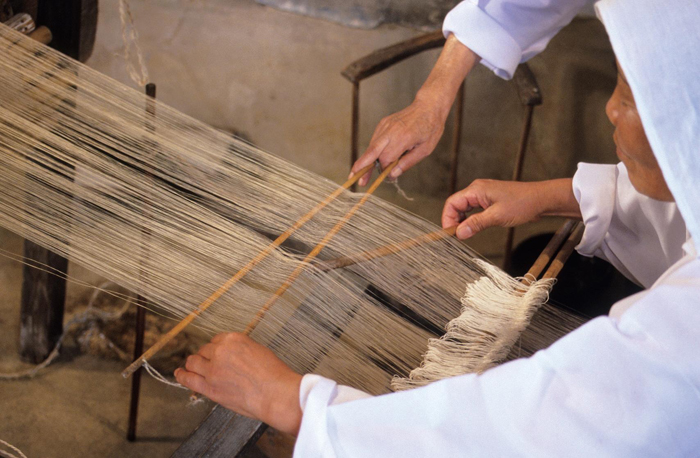
Hansan Mos, Mosi, or fine ramie, made in the Hansan region of Chungcheongnam-do (South Chungcheong Province), is a woven cloth made from the husks of ramie plants. Traditionally used for summer clothing, mosi has long been a symbol of Korea’s unique aesthetic tradition.
Weaving of Mosi in Hansan is transmitted by middle-aged women in the township located in South Chungcheong Province, Republic of Korea. The region boasts fertile land and sea winds that allow ramie plants to thrive. Weaving ramie cloth involves a number of processes, including harvesting, boiling and bleaching ramie plants, spinning yarn out of ramie fibre, and weaving it on a traditional loom. Ramie cloth is comfortable in hot summer weather and is used to produce a variety of clothing from dress suits and military uniforms to mourning garments. The whiteness of the bleached ramie fabric, as well as its refined quality and neatness, makes it suitable for high-end clothing as well as for clothing for ordinary people. Weaving of Mosi traditionally takes place in the form of women-led family operations in which mothers transmit techniques and experience to their daughters or daughters-in-law.
The tradition also binds the community together with neighbours gathered and working in a designated section of the town. At present, around 500 people in the province are engaged in the diverse activities of weaving fine ramie.
Arirang is a popular form of Korean folk song and the outcome of collective contributions made by ordinary Koreans over many generations. Essentially a simple song, it consists of the refrain ‘Arirang, arirang, arariyo’ and two simple lines which differ from region to region. For more information about UNESCO Treasures in Korea, go to www.cha.go.kr.

